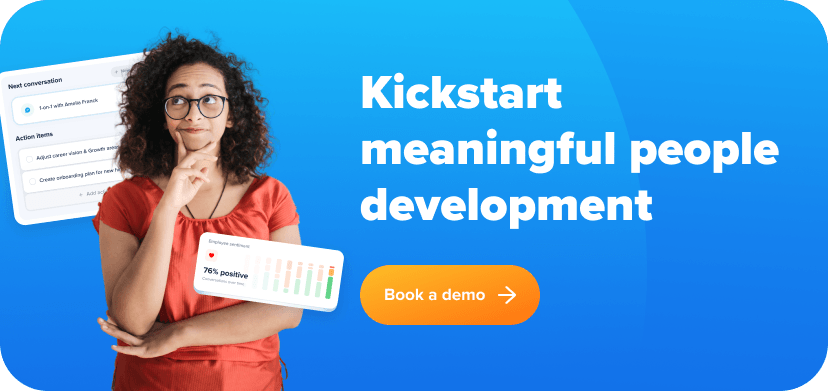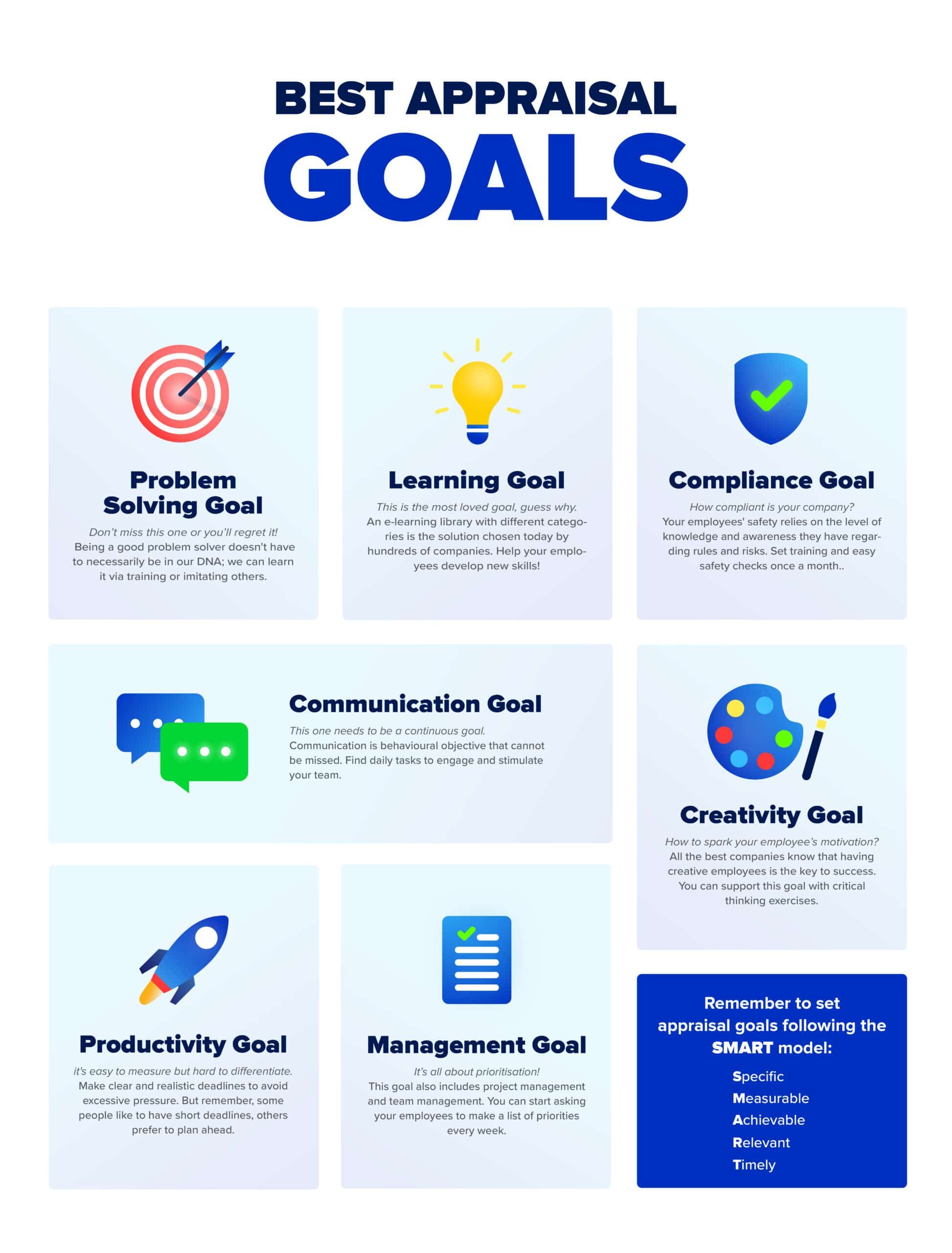The Importance of Performance Appraisals & Goals
Performance appraisals and goals are key to the long-term growth and success of any company. Performance management is so important because it provides employees with clear expectations and objectives, helping to align their efforts with organizational goals.
Additionally, performand appraisals and goals offer a structured mechanism for feedback and assessment, enabling employees to track their progress, receive guidance, and make necessary improvements, ultimately contributing to personal and organizational growth.
Collaborating with Employees on a Better Performance Process
Before writing down a list of performance appraisal goals and objectives, it’s necessary to understand what an appraisal is in a work context. Performance reviews are defined as a meeting where employees discuss aims, results and progress together with their managers.
I would add that, to do it properly, an appraisal needs a structure and a shared perspective to be effective. It’s like taking a picture of a growing process. With a smart and transparent performance management system, you can get an instant overview of relevant topics, agenda items, and goals to quickly check-in on employee progress or address difficulties.
If you want to identify strengths and weaknesses with a tailored, personal approach for each employee, it can be challenging. So consistent processes (that allow room for collaboration) become even more necessary. I suggest you check your appraisal system and verify if it’s objective and consistent. Another helpful tip is to ask your employees’ opinions about the current performance evaluation process.

In Doubt About Performance Appraisal Goals? Read This!
Setting performance appraisal goals for your employees is a necessary action to see your company growing and keep the best performers. It’s simple math; an achieved goal corresponds to the employee’s satisfaction and it’s built with talent and motivation.
The level of motivation relies on your ability to encourage and inspire your team, as they say, it takes two to tango.
A modern and customised list of performance appraisal goals can certainly help to get the expected results without missing essential steps and details. The question is, are you up for it?

The Best Time for Performance Appraisals
An the old proverb goes, “The best time to plant a tree was 20 years ago. The second best time is now.”
I think this is perfect advice for both employees and managers. There isn’t, in fact, the best time to improve because it’s always good to move forward and beyond our limits.
Employees feel the same about their possibilities within an organisation; therefore, it’s crucial to nurture more than one aspect of their professional growth.
A tailored plan with several milestones and more insights about the various performance levels (including feedback, self-feedback, learning steps, 1:1 sessions) is what everyone should have nowadays at work. A yearly performance appraisal can easily fall into the list of burdens rather than the empowering ones.
Remember that being aware of our development requires constant observation from more angles.Now it’s time to change this into a new modern solution that can make the review process a satisfying experience.
Choosing Performance Appraisal Goals Wisely
No job exists without its problems. Issues are inevitable and must be quickly analyzed and resolved to achieve greater efficiency.Because we are all different, we are all motivated by different challenges and objectives. In our professional path, we always encounter exciting tasks as well as undesired ones that we wish to avoid. Also, some of us like direct comments or inputs, while others prefer indirect feedback.
A structured and continuous performance appraisal system allows you to know your people better. Checking in on your employees’ status once a year won’t let you discover much more about their personality and attitude. Instead, an ongoing performance review will expand your understanding of a person with important details and insights and lead you to an impressive, three-dimensional image.
Why does all this matter? Having a better understanding of both your employees’ goals and business KPIs will help you to choose performance appraisal goals that are more meaningful, and achievable, for each individual. Read more here if you want to know how to measure and improve employee performance with KPIs.

Put Your Pen Down!
If you are like me, a fan of pen and paper, this will hurt a bit. It’s time to say goodbye to paper processes. They did a remarkable job, but times are irremediably changing. With new generations entering the labor market, your employees are becoming increasingly more digitally savvy – and expect systems to match. Just think about the jump to tools like Microsoft Teams and Zoom during the pandemic.
Luckily, one of the best parts of this process is that it will show you the immediate effects of digitalization for both managers and team members. Digital platforms allow HR to easily manage performance reviews, while creating a single hub for employees and managers to run check-ins, set goals and objectives, and create personalized development plans. There’s so much more to going digital than just time-saving, which you’ll undoubtedly appreciate as the first improvement in your workflow.
You Don’t Have To Guess Your Employee’s Best Skill
When setting performance review goals, it’s essential that objectives match employee expectations and ambitions. How do we get there? Having a clear picture of their abilities, current development, and goals status is necessary to set relevant training and development plans.
The good news is you don’t have to start from scratch. Solutions like eloomi Skills allow you to create a skills map of your organization, uncovering the skills your employees have, need, and want to develop. With clear insight into company skills data, it’s easy to prioritize learning paths for your employees based on their role and ambitions. So, don’t go into your performance reviews blind. Start out by exploring skills.

The Two Types Of Motivation
I want to share with you something that I recently read and found deeply interesting about motivation. You probably heard that we have two different kinds of motivation not necessarily related to the division between private and public life.
The type of motivation that we experience can be intrinsic or extrinsic, and this deeply affects our needs and satisfaction level. What’s the difference between the two? To sum up and make it simple, we can say that extrinsic motivation needs external rewards to be fulfilled.
On the other hand, the intrinsic motivation doesn’t need to have an incentive that comes from external elements like prizes or factors like pressure. Your performance reviews should try to balance different types of motivation, and speak to your employees’ personal and career-oriented goals.
Want To Build A Performance Review That Stands Out?
A performance review goals strategy starts with having simple and effective pillars that support the whole structure. You can decide the best one, a roadmap or a step-by-step one?
Start with these four great ideas:
- Design your performance reviews in a way that resonates with your company culture
- Make it modern and fun because you have a new generation to motivate
- Improve your employees’ skills like emotional intelligence, negotiation, intercultural communication, cybersecurity awareness
- Follow progress reports and key outcomes to ensure your PM process works for you

How To Set Smart Performance Review Goals
Once you get a unique structure for your employee’s review, you are ready to set performance review goals together with your employees and align expectations.
Remember to construct these performance review goals it in a smart way that is following the SMART model. Let’s have a quick recap:
- Specific (clear & simple)
- Measurable (cost, numbers, frequency)
- Achievable (realistic)
- Relevant (align with values and objectives)
- Timely (within a timeframe)
Besides, you can establish the types of objectives choosing among daily goals, project-based goals or stretch goals.
Setting and defining them transparently helps to avoid any bias, inaccuracies and encourages to add some challenges for future development.
This process enhances trust, proactivity and motivation because the list of performance goals shows progress in time and projects greater expectations of new results. The sky is the limit!
Keep It Human
Before sharing the list of performance review goal examples with you, let me say something. The performance evaluation system doesn’t have to replace face-to-face interaction with your employees. If you establish a genuine dialogue in person, you can reach your employees’ motivation without missing any points or leaving blind spots.
The performance review system will help you and ensure the consistency and accuracy of this professional dialogue.
It’s easier to receive and give feedback when we have a meaningful relationship with our colleagues.
The best possible scenario would have virtual communication that mirrors a trustful and transparent daily interaction.
Types of Performance Review Goals
If you want to further understand the types of performance review goals you could set, we’ve assembled a list below to give inspiration and guidance. But you might also be interested in our article on goals for performance review examples – with a full list of examples and templates you can use in your performance review sessions.
- Productivity goal – it’s easy to measure but hard to differentiate. For this one, for example, you should be able to customise it as a team or an individual goal. Be clear and realistic with deadlines to avoid excessive pressure. Some people like to have a short time to deliver, others prefer to have longer periods.
- Learning goal – perhaps this is the most loved goal. Learning something new is always a good feeling and investment, but you should know who needs what, right? An e-learning library with different categories is the solution chosen today by hundreds of companies.
- Communication goal – communication is probably on your employee’s plan. Still, this one needs to be a continuous goal; it belongs to the essential behavioural objectives. What about team meetings with everyone speaking for at least five minutes? Improving soft skills is the icing on the cake!
- Compliance goal – how compliant is your company? The truth is that you should say ‘yes’ only when all your organisation members are. Your employees’ safety relies on their level of knowledge and awareness of rules and risks. I suggest you set training and easy safety checks once a month. Is that fair?
- Creativity goal – luckily, being creative has lately become more and more important. All the best companies know that having creative employees is the key to success. But, how to spark their motivation wonderfully? You can set this goal as personal development or a team one; it can be based on critical thinking activities or new creative challenges. In case you haven’t already focused on this goal, it’s about time.
- Problem-solving goal – solving problems has something to do with the creative goal. Being a good problem solver doesn’t have to be necessarily in our DNA; it’s something that we can learn via training or imitating others. It’s also an attitude, a precious one. Ensure that your employees have the right amount of time to develop this one.
- Management goal – management skills are always a company priority. You can consider this a broad goal that includes more detailed ones like time management, project management and team management. Asking your employees to have a list of priorities every week is an excellent example of these types of goals. You can also consider an efficiency goal linked to management skills. Instead, people management can be under communication goals.

Keeping Performance Appraisals Simple
The list can be expanded according to the various roles and includes, for example, leadership or attendance goals. At this point, we indeed agree that ‘one size fits all’ won’t work for setting employee appraisal goals.
Besides, different companies have different ways too, but this doesn’t mean it will be complicated!
Once you have the right tool, you can start and create your reviews effortlessly. With eloomi, you find the most customizable platform that helps to keep it simple and effective. Once you start, it is like riding a bicycle.
Finally, you can leave that huge excel file and transform the evaluation system into something extraordinary for both managers and employees! Remember that it’s vital to identify high performers and keep them engaged with exciting challenges.
Discover Impactful Performance Appraisals with eloomi
The appraisal system can seriously give results beyond imagination. I am talking about training and career development, promotion and rewards, recognition and satisfaction.
Let’s spill the beans; people don’t like to be measured and labelled with numbers or percentages. Managers would rather run away than deal with this. You and I know that. But the reality is that we can’t avoid performance reviews; we need them to meet targets and check our employees. Are they happy? Productive? Satisfied? If you don’t want to see your best performers leaving the company, you need to answer these questions.
Take the next step to building a scalable and impactful performance appraisal system in your organization. Explore how performance management software can support your company as it grows, or get in touch with us to troubleshoot your performance management challenges and find a solution that works for you.
FAQs
What is the goal of a performance appraisal?
The goal of a performance appraisal is to evaluate an employee’s effectiveness and development needs. eloomi’s L&D platform offers customizable solutions to track and assess employee performance.
How often should performance appraisals be conducted?
Performance appraisals should be conducted at least annually, but this can vary depending on the organization’s needs. eloomi’s L&D platform offers automated workflows and scheduling options for streamlined performance appraisal processes.
What are the benefits of using an LMS platform for performance appraisal?
Using a comprehensive LMS platform for performance appraisals provides efficient tracking, comprehensive reporting, and easy access to training materials to put development plans into action. eloomi’s L&D platform offers customizable solutions and ready-made content to streamline performance appraisal processes.
How can an LMS platform improve employee development?
An LMS platform can improve employee development by providing access to training materials and tracking progress. eloomi’s L&D platform offers a library of ready-made content to connect learning and development inside a single, easy-to-use platform for employees and managers.
What is the role of managers in performance appraisal?
The role of managers in performance appraisal is to provide feedback, set goals, and evaluate employee progress. eloomi’s L&D platform offers paperless people development and automated workflows to streamline communication between managers and employees during performance appraisal processes.






